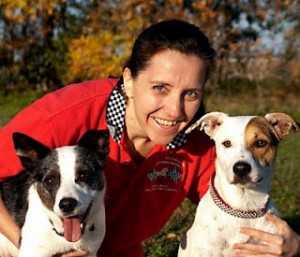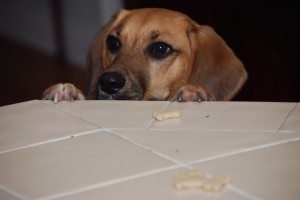dog training
Think You Have a Dumb And Stubborn Dog? Probably Not.
Note: I have a new pet behavior blog at http://www.SoMuchPETential.com/blog.
(one of my past columns from Hyde Park Living)
It was through a parrot behavioral analysis email listserve that I met Jeni Rivett. She is an Arizona-based agility dog trainer, sharing her home with three fully flighted birds and four energetic dogs. I still have one of her posts from years ago when she described how, on cue, all seven of her animals fly or run to their cages. What an amazing site, I remember thinking. When I wrote to her, she described in detail how she taught them.
Jeni, like other trainers with whom I respect and learn from, doesn’t train using ‘pack leader’, dominance-based methods. Although, like so many of us, she did try those other punishment based techniques first. What she and everyone who has ever taught animals (including the human kind) has learned, is that by far, positive reinforcement based training gives her the best results. Behaviors she teaches using positive reinforcement are stronger and done with much more enthusiasm because animals are eager to learn when they are rewarded for their actions. Additionally,  teaching in this way serves to build stronger relationships – and that’s something we all want.
teaching in this way serves to build stronger relationships – and that’s something we all want.
Take Sophie for example. The once unhappy dog housed in small quarters of a pet store who later was labeled stupid and stubborn, turned out to be excessively smart when her teacher began using different strategies. The problem – Sophie’s newly adopted mother, that would be Jeni, unwittingly took her to a place that trains police dogs to learn about obedience. They employed practices we’re all too familiar with like jerking the collar. In behavioral terminology, that is called positive punishment, and, as is the danger in using that type of method, Sophie quickly learned to hate training. Can you really blame her?
“I really just thought obedience wasn’t for Sophie,” Jeni said.
There’s a dynamic that happens a lot, Jeni explained. When an animal becomes non-compliant we tend to want to make them do what we want. But when the relationship is adversarial (whether just humans or humans and animals), it just doesn’t work. There are so many possible negative ramifications, aggression and lack of interest are just two.
It was by fluke that Jeni learned about agility training, training that is done with positive reinforcement instead. Suddenly Sophie was catching on, and fast. In two days, that dumb animal had caught on to everything. Everything. It has transformed Jeni’s teaching approach, and as a result, she lives with a house full of really smart companions.
Now Jeni sees her role as more of a team captain and collaborator, rather than a pack leader. “I work really hard to listen to my animals. If I’m having trouble training a behavior, I know there is good reason for it. As the teacher, I look at what I can do better to explain what I want. Maybe I’m not reinforcing my dog for what I want to see more of, maybe my timing is off for providing reinforcement, or maybe I’m asking for too much,” she said.
So, how would someone go about teaching a dog ‘not’ to do what we don’t want – like jumping on the plushy and very expensive sofa in the living room?
“Think about your goals,” Jeni advises. “If I had a dog I didn’t want on my couch, I’d realize he needs a comfortable alternative, otherwise we’d all be sitting on the floor.”
So, first step. Get your dog the most comfortable, plushy pillow or bed you can find and place it in the same room as the sofa you’d rather left to humans. Then get a nice supply of your pet’s all time favorite food or toy treats. Put the treats on the acceptable pillow and when your dog comes over, up the reward with extra human attention. Wow, it doesn’t get much better than that.
Your goal is to make being on that pillow the most totally awesome place to hang out because look at all the reinforcement your friend gets for being there, not to mention it’s sooo soft. Next time you see your dog on your sofa, instead of scolding him (remember punishment is bad for relationships and serves no teaching function), simply ignore him, go to his pillow and have a great time without him, playing with his favorite reward no less. How soon do you think it will be before he ‘chooses’ to go to the pillow instead because he associates it with so much that is positive? You can even put that on cue if you’d like.
Jeni’s dogs never get in trouble for being on her couch, they just get reinforced for being somewhere else. Instead of being punished for doing something wrong, they are rewarded for doing something that is acceptable.
“I’ve found that when I offer plenty of opportunities for reinforcement for everyone, the whole household is a more pleasant place to be,” she said. “There is no such thing as a dumb dog, they just need to be shown what they need to learn. If you can fix the trainer, you can fix the pet.”
ABC’s of Pet Behavior, Part Two
Note: Please visit my pet behavior blog at http://www.SoMuchPETential.com/blog.
(from my Hyde Park Living column)
Last month I explained the ABCs of behavior and we can use them as the most positive, least intrusive way of managing and modifying our pet’s behavior. This month I thought I’d show you a little how it works.
First, let me recap. Applied behavior analysis is a systematic approach to solving behavior problems by changing the environment in which the behavior occurs. It involves looking at the very specific behavior (such as a bird biting or screaming) and the related environmental context that signals and reinforces it. We ask, “What happened *immediately* prior to the behavior (antecedent) to set the whole ball rolling?“ And, “What happened *immediately* after the behavior to reinforce it (consequence)?“
I’m going to use the example of our family dog, Sam, who has an earned reputation for pawing my mom when we eat or standing with his two front paws on the table looking for a prize. For the purpose of this column, I will label that set of  observable behaviors as ‘bad table manners.’
observable behaviors as ‘bad table manners.’
The setting event for ‘bad table manners’ is our sitting around the table with food. The consequence may be any number of things…my mom trying to ignore him but sometimes hugging him, sometimes telling him he’s bad, sometimes giving him a treat. You get the picture?
Since I know under what conditions his behavior is highly predictable, I can decrease the value of that behavior with antecedent strategies. I can play rough with him just prior to our sitting down to get him tired and less motivated to have ‘bad table manners.’ I can (and always do) make him a foraging toy that he only gets before we eat and that keeps him busy for awhile. (I break up pieces of treats, and intertwine them in knotted plastic grocery bags that are then stuffed into a heavy rubber ball.)
Another thing I have done was teach him an alternative behavior (actually he knows a lot of behaviors) that, when we are sitting at the table, he knows in black & white terms that *if * he does that behavior next to me – which I chose as sitting or laying down – *then* he will get reinforced with attention and small pieces of food. (Okay, I admit I feed him some at the table but only when he is doing a behavior I taught him is acceptable.) At the same time, I have removed all positive consequences of his bad table manners (which meant when he jumps or paws, I simply turn my back and push my plate to the center of the table).
Guess which behavior he does more of now? Heck, if I were him and I REALLY wanted a taste off that plate, and knew the only sure fire way of getting a sample was to sit or lay down, I think I’d choose to sit or lay down too. And I’d do it pretty darned fast.
What is so wonderful about this is that punishment never had to be used, only empowerment. Sam has learned to succeed because I am clear cut in teaching him what I want him *to* do and because I make learning fun. Let me say that again. At every step along the way…learning is fun.
To read part one, please click here.
Do You Know The ABC’s Of Pet Behavior?
NOTE: I have a new pet behavior blog located at http://www.SoMuchPETential.com/blog. Thanks!
(past Hyde Park Living column)
Do you know your ABC’s?
Well that’s a strange question you may be saying to yourself. Isn’t this a pet behavior column?
Yep, it sure is. And the ABC’s I’m talking about are not related to spelling words. They are instead what I have been taught to help me understand why a behavior occurs so that as a pet owner and teacher, I can effectively set my animals up for success by influencing their behavior in the most positive/least intrusive way.
Let me back up. What I really would like for you to get from this column is a basic understanding that blaming an animal for doing anything you don’t want him to do is simply counterproductive. All behavior happens because it is serving a purpose for that animal. We may never know at any given time what our animal is feeling or thinking when he jumps on us or chews up a garden hose but we don’t need to know to still set our animal up to succeed. Using the ABC assessment, we can modify the animal’s environment and modify his behavior without any use of force or punishment.
The science of behavior
Applied behavior analysis is a systematic approach to solving behavior problems by changing the environment in which the behavior occurs. It involves looking at the very specific behavior (such as a bird biting or screaming) and the related environmental context that signals and reinforces it. We ask, “What happened *immediately* prior to the behavior (antecedent) to set the whole ball rolling?“ And, “What happened *immediately* after the behavior to reinforce it (consequence)?“
 There you have it…the A (antecedent), B (behavior), and C (consequence)’s.
There you have it…the A (antecedent), B (behavior), and C (consequence)’s.
All too often when our pet is doing something we disapprove of we don’t even realize that we are responsible for reinforcing the very action we don’t want to see. Or in the heat of the moment, we end up punishing our pet – which can have detrimental side effects (the subject for a future column) and serves no teaching function.
Using the ABC assessment tool allows us to consider how we can rearrange the antecedents so that the problem behavior is never set into motion to begin with – and we can set into motion an acceptable behavior instead. Then we can reinforce the heck out of the acceptable behavior. Guess which behavior you’ll see more of?
In my next column I’ll work through a specific example of using the ABC analysis in solving a pet behavior issue.














